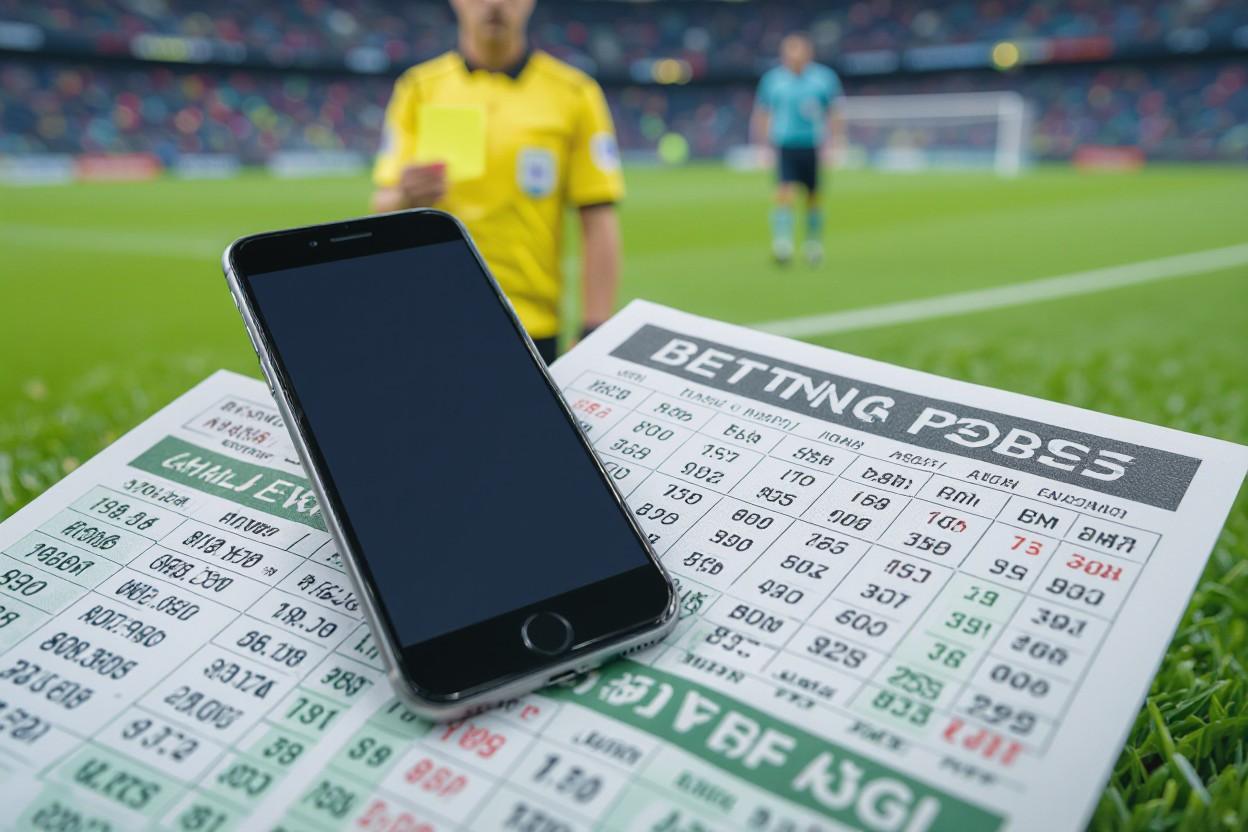
Betting on Yellow Cards: A Guide to Discipline-Based Bets
There’s betting on yellow card strategies that reward bettors who study referee patterns, team aggression and match flow; focus on value spotting, manage bankroll for high-risk swings and apply strict staking to convert short-term variance into consistent profit.
Betting on Yellow Cards: Understanding Yellow Cards
Referees issue a yellow card as an official warning for misconduct such as reckless tackles, dissent, simulation, or timewasting; two yellows equal a red and force a substitution. Bookings shift momentum and market pricing, so bettors track referee averages, player histories, and match context for betting on yellow card.
Types of Yellow Cards in Football
Tactical fouls to stop counters, dissent directed at officials, simulation to win penalties, persistent minor fouls across a match, and delaying restarts are common booking reasons. Late-match tactical fouls and derby heat often push averages above 3 cards; teams conceding 1.2 expected goals tend to commit more fouls. Analysts use these patterns for betting on yellow card models.
- betting on yellow card: track referees who average >3 bookings per match.
- betting on yellow card: monitor players with ≥0.4 bookings per 90 minutes.
- betting on yellow card: factor fixture type — derbies and knockouts spike cards.
- Thou watch live tempo shifts after early tactical fouls when betting on yellow card.
| Offence type | Example & impact on match |
| Tactical foul | Stops counter; often 60–85′ bookings |
| Dissent | Yellow for arguing; can escalate to second booking |
| Simulation | Usually draws caution in penalty areas |
| Persistent fouling | Accumulates across match; raises totals |
Some leagues average ~3.1 yellow cards per match while top defenders log 0.4–0.8 bookings/90. Tactical fouls rise after the 60th minute as teams protect leads and referees from certain countries show 15–25% higher booking rates; modelers weight these variables for profitable betting on yellow card selections.
- betting on yellow card: check referee season variance and recent fixtures.
- betting on yellow card: use team/league averages (e.g., 3.1 cards/match) to set thresholds.
- betting on yellow card: favor in-play markets after clear tactical changes.
- Thou size stakes conservatively when betting on yellow card due to high variance.
| Metric | Typical value / use |
| League average | ~3.1 cards per match (benchmark) |
| Player role | Defender 0.4–0.8 bookings/90 |
| Referee style | Lenient vs strict: avg cards differ by ~1.0 |
| Betting market | Total cards, player booking, first card |
Types of Bets on Yellow Cards
Betting on yellow card markets include totals, player props, first-card and team-specific lines; common league averages hover around 3 yellow cards per match and pricing relies on referee tendencies and competition stakes. Bookmakers lean lines toward referees who average higher or lower bookings. Any sharp strategy cross-references referee season rates, team fouls per 90 and fixture context.
- Over/Under match totals
- Specific player yellow card bets
- First/next card
- Team card totals
- Card handicaps & special markets
| Over/Under totals | Lines like 2.5, 3.5 or 4.5 based on referee & team styles |
| Player card props | Player-to-be-booked markets use cards/90 and minutes played |
| First/next card | Short-term in-play or pre-match bets on which team/player |
| Team card totals | Separate totals per side, useful when one team presses high |
| Card handicap | Bookmakers shift the spread to balance liability |
Over/Under Yellow Cards
Bookmakers set betting on yellow card totals at common thresholds: 2.5, 3.5, 4.5. Lines reflect referee averages (e.g., refs with 4+ cards/game push higher lines) and team metrics like fouls per 90; a 3.5 line favours over if both teams average >1.6 cards/90 each. Value appears when public lines ignore a referee’s recent spike or a derby’s historical extra bookings.
Specific Player Yellow Card Bets
Player bets price on season cards/90 and minutes—defensive midfielders averaging 0.4 cards/90 imply ~15 cards across 38 matches; odds adjust for likely starters and substitution risk. Bookmakers also factor last-5-match booking trends and rivalries when pricing a player’s chance of being cautioned.
Deeper analysis uses per-90 rates, role (e.g., holding midfielder vs. fullback), and referee-player historical interactions: a player with 0.35 cards/90 who plays 2,700 minutes projects ~10–11 bookings per 34 matches, but a tendency to pick up yellows late in games (70–90′) lowers pre-match value if coach substitutes him early. Weather, competition (league vs. cup), and tactical matchup (aggressive press vs. possession teams) shift probabilities; shop across markets for better handicaps or in-play timing props to exploit mispriced lines.
Tips for Successful Betting on Yellow Cards
Betting on yellow card strategies profit from specific filters: prioritize fixtures where teams average >3.0 fouls and >3 yellows per match over the last 10 games, and cross-check referees who averaged 3+ bookings per 90 minutes. After isolating high-foul teams and card-prone referees, scale stakes conservatively and prefer in-play overs when early fouls push totals up.
- Target matches with both teams averaging >3 yellows per game over 10 matches and monitor home/away splits.
- Watch lineup news: loss of a disciplined central defender often raises booking risk.
- Filter by referee stats: prefer refs with 3–5 cards per game and avoid those under 2.0.
- Use betting on yellow card in-play markets after the 30–60′ window when booking probability spikes.
- Limit exposure to 1–2% bankroll per specialty discipline bet and log outcomes for edge refinement.
Analyzing Team Discipline
Compare fouls per match, cards per 90 and the last-10-match trend: teams committing >12 fouls and averaging >3 yellows over ten games present higher over/total value; inspect set-piece concession rates and aggressive fullbacks—these often concentrate bookings in the 60–90′ period; use head-to-head data to detect tactical patterns that produced 4+ cards in past meetings.
Understanding Referee Tendencies
Quantify each referee by cards per 90, yellow-to-red ratio and half-by-half distribution: refs issuing ≥4.0 cards per match increase over/total likelihood, while some show a second-half bias (40–60% of bookings occur after 60′). Cross-reference seasonal samples (20+ matches) to avoid small-sample noise.
Dig into assignation patterns and historical clashes: certain referees penalize tactical fouls and are strict on persistent infringement, yielding 0.5–1.0 extra cards per match versus lenient peers; factor VAR intervention rates and league-level averages (many top divisions average ~2.5–3.5 yellows per game) to calibrate model thresholds and staking plans.
Step-by-Step Guide to Betting on Yellow Cards
Use referee profiles and team foul rates: betting on yellow card strategies often hinge on refs who average 3.7 cards per match or teams committing >12 fouls per game.
Quick Checklist
| Factor | What to check |
| Referee | Avg cards/game, last 10 fixtures, home vs away variance |
| Teams | Fouls/game, aggressive midfielders (≥3 tackles/game), derby history |
| Context | Competition style (e.g., Copa Libertadores averages >4 yellows), weather, stakes |
Researching Matches for betting on yellow card
Cross-reference referee card rates with team booking tendencies: filter matches where ref average >3.0 and both teams average >10 fouls; use season splits (home/away) and H2H data—for example, Liverpool vs Man City ran at 3.9 cards average across last 12 meetings, signaling value on over 3.5 yellow cards.
Placing Your Bets for betting on yellow card
Target markets like First Half cards, Total Cards (over/under 2.5–4.5) or individual player bookings; stake 1–2% of bankroll, increase to 3% only with multi-factor edge (ref, team style, match importance). Live betting performs well after early fouls or a red card that raises subsequent caution likelihood.
Shop odds across bookmakers and use cash-out sparingly: compare implied probabilities, consider Asian totals to reduce variance, and when in-play, hedge if odds drop below fair value; expect high volatility—manage stakes and avoid chasing losses after a single volatile match.
Factors Influencing betting on yellow card Bets
Betting on yellow card wagers depend heavily on referee strictness, team fouling rates and match tempo. Statistical filters like average cards per match (many top leagues hover around 3 cards) and head-to-head history help quantify risk. Use player card trends and referee averages together to spot value.
- Referee profile — average yellows per match, leniency
- Match intensity — derbies, cup ties, knockout stakes
- Team tactics — high-press or physical defending
- Player discipline — suspensions, booking frequency
Any nuanced bet pairs referee data with live match context to avoid surprises.
Match Context and Rivalries
Derbies and heated rivalries routinely push totals above league averages; many high-stakes matches record 4–6 yellow cards as tempers flare and tactical fouling increases. Knockout fixtures and late-table survival games also spike disciplinary incidents, while early goals can change tactical fouling patterns. Historical head-to-heads, recent derby card counts and stakes-related aggression are strong predictors for match-level betting on yellow card markets.
Player Behavior and Form
Players with persistent booking histories (e.g., 4+ yellows in recent 10 matches) or roles that demand frequent challenges—defensive midfielders, aggressive full-backs—carry higher booking probability; metrics like fouls per 90 and tackles per game quantify that risk. Suspension threat after accumulation (often 5 bookings in several leagues) raises both likelihood and market value for betting on yellow card props.
Deeper analysis should track recent form: a player averaging >2 fouls/90 over the last five matches, combined with a history of dissent or tactical fouling, increases single-game booking probability by a measurable margin. Referee-player history matters—some referees book specific players disproportionately. Satellite signals like pick-up in fouls after scoreline changes, substitutions that expose inexperienced defenders, or tactical shifts (e.g., man-marking ramp-ups) can all push a player from low-risk to high-risk for a yellow card.
Pros and Cons of Betting on Yellow Cards
betting on yellow card markets reward bettors who profile referees and match context: Premier League averages near 3.1 cards/game, derby fixtures often spike above 4.
Pros vs Cons
| Pro: Clear statistical edges when referees and teams are profiled | Con: High variance—one unexpected red or substitution can skew outcomes |
| Pro: Numerous micro-markets (first card, cards 2+) | Con: Thin liquidity on niche markets limits stake size |
| Pro: Live in-play opportunities to exploit momentum | Con: Bookmakers often move lines quickly on visible aggression |
| Pro: Data-driven models can produce consistent ROI | Con: Bookmaker limits and restrictions for successful bettors |
| Pro: Correlated indicators (fouls, tackles, heatmaps) aid selection | Con: Referee inconsistency and rule interpretation create unpredictability |
Advantages of Discipline-Based Bets
Focused discipline bets let you exploit observable patterns: referees who average >3.5 cards and teams averaging >12 fouls/90 create measurable edges; backing those scenarios can yield better-than-market value when line movement lags scouting reports or live momentum shows escalating tempers.
Risks and Challenges
Sharp variance, referee subjectivity, and bookmaker behavior are top risks; even accurate models can be undone by a single lenient official or a strategic coach substitution that cools aggression, producing streaky returns and potential account restrictions.
Further, market depth matters: major leagues offer more consistent odds, while lower divisions and cup ties often have volatile lines and limited liquidity, making stake sizing and bankroll management vital—use small, disciplined stakes and track referee-specific EV over 100+ matches to validate hypotheses.
To wrap up
Considering all points, betting on yellow card demands clear rules, strong discipline, and thorough match analysis; use statistical trends, referee profiles, and in-game dynamics to set limits, manage bankroll, and choose value markets. Learn the meaning of a yellow cards and apply consistent staking models, live observation, and risk controls to convert knowledge into steady returns while minimizing volatility and emotional bias.



